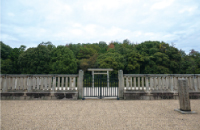Episode 10:
An Ingenious Scheme
From the Kojiki, Volume II
“Rebellion by Oshikuma-no-miko”
When Tarashinakatsuhiko no Sumera-mikoto (Emperor Chūai) and his consort, Okinagatarashi-hime no Mikoto (Empress Jingū) were on an expedition, the Emperor suddenly died. One of the gods was enraged because the Emperor did not believe in prophecies, and had him killed. Empress Jingū came back to Yamato with her son who was born during the expedition.
Dangerous things tend to happen in situations like these. Empress Jingū felt anxious about something happening and prepared a mohune, or a ship for carrying the dead. She put her son and some soldiers in the ship and lied to people who asked about her son, saying that he was already dead.
When Kagosaka no Miko and Oshikuma no Miko (her son’s half brothers) heard this news, they made a plan to overthrow the Empress and awaited her return. They went hunting in Togano (now Osaka Prefecture) to see how good their fortunes were, but Kagosaka no Miko was killed by a furious wild boar.
Oshikuma no Miko was not deterred by this. He tried to attack the mohune and approached it. However, he did not know the ship was an ambush.
Naniwaneko-takefuru-kuma no Mikoto, a general who served Empress Jingū, devised the trap. He said, “Empress Jingū is already dead. We should not fight any more.” He cut his bowstrings and pretended to surrender to Oshikuma no Miko.
A general who served Oshikuma no Miko believed this completely. He too removed the string from his bow and dropped his weapons. Takefuru-kuma no Mikoto took an extra bowstring from his hair and restrung his bow. He then attacked Oshikuma no Miko’s men all at once.
Defeated by this ingenious scheme, Oshikuma no Miko had no escape route, so he jumped into Lake Biwa. Generally speaking, history repeats itself. It is very interesting to note that psychological warfare, which is carried out today, was also employed during ancient times.
Related tourism site:
Saki Kofun Group: Misasagi-cho, Saki-cho, and Hokkeji-cho, Nara City
Tumuli in this group were constructed around Saki Hill. Huge keyhole-shaped tumuli exceeding 200m in length have been identified as the Imperial Mausoleums for the Emperor and Empress and a reference referential imperial mausoleum. Other imperial mausoleums of empresses described in the Kojiki include the mausoleums of Empress Jingū (Okinagatarashi–hime no Mikoto), the Empress of Emperor Suinin (Hibasu-hime no Mikoto), and the Empress of Emperor Nintoku (Iwano-hime no Mikoto).
